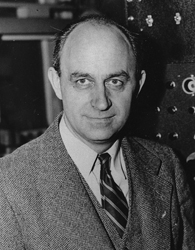Enrico Fermi’s pioneering work in the field of nuclear fission won him a Nobel Prize, and ushered in the nuclear age. His discoveries led to the creation of the atomic bomb that ended World War II.
Enrico Fermi’s Early Days
Born September 29, 1901 in Rome, Italy, Enrico Fermi was the youngest of three children born to Ida de Gattis, a schoolteacher, and Alberto Fermi, Chief Inspector of the Ministry of Communications.
When he started at the local grammar school, Fermi was immediately recognized as having particular skill with physics and math. In his spare time, Fermi designed and built small electric motors and drew plans for airplane engines. After the death of his brother following a surgical procedure in 1915, Fermi busied himself reading books about physics. It was during this time he decided to make a career of his scientific and mathematical pursuits.
After being awarded a full scholarship to the prestigious university, Fermi attended Scuola Normale Superiore of Pisa for four years and was awarded a doctorate in physics.
Sources in this Story
- Nobel Prize.org: Enrico Fermi
- Franklin Institute Case Files: Enrico Fermi
- Atomic Archive.com: The First Pile
- U.S. Department of Energy: The Manhattan Project
- The New York Times: Enrico Fermi dead at 53
Fermi’s Notable Accomplishments
Seeking to reproduce the recent experiments of Irene and Frederic Curie-Joliot which created the world’s first artificial radioactivity, Fermi took to his laboratory in 1934. By applying the methodology of the Curie-Joliots but with different elements, Fermi succeeded in creating a new element—Number 93. To get there, he bombarded a series of elements with neutrons and measured their radioactivity. He found that uranium produced the largest amount of radioactivity—a move some say was the spark that started the nuclear age.
In 1938, Fermi was awarded the Nobel Prize in physics for his work identifying and creating these radioactive elements.
“Along with Fermi’s significant discoveries, and to a certain extent equivalent, can be placed his experimental skill, his brilliant inventiveness and his intuition,” the chairman of the Nobel committee said during his speech inducting Fermi. “These qualities have found expression in the creation of refined research methods which made it possible to demonstrate the existence of these newly formed substances, which occur in extremely small quantities.”
Soon after receiving the Nobel Prize, Fermi moved to America, where he continued his work. He discovered that when bombarded with neutrons, uranium would split and create two new atoms. Those two would split as well, and the splitting would continue. While splitting, the atoms would release an immense burst of energy. Thus, fission and nuclear chain reactions were discovered.
On December 2, 1942, under a field in Chicago, the first nuclear reactor went into operation. It was an experiment designed by Fermi and other scientists to see if they could harness and control the nuclear chain reactions. They could, and that day is now remembered at the birthday of the atomic era.
Fermi then set to work harnessing his nuclear reactions to build a weapon. In 1944, he moved his family to Los Alamos, New Mexico, to oversee work on the atomic bomb. This effort was also known as The Manhattan Project. Fermi’s code name for the effort was “Mr. Farmer.” On July 16, 1945, Fermi sat 10 miles from the test site and witnessed the detonation of the world’s first atomic bomb. Less than a month later, similar bombs were dropped on Hiroshima and Nagasaki, leading to the end of World War II.
The Rest of the Story
After the war Fermi continued his research, focusing on cosmic radiation as an unlimited source of energy. He died on November 28, 1954, from stomach cancer. After his death he was remembered in a number of ways: schools and awards are named after him; an atom, number 100 on the periodic chart, is named fermium; Time magazine named him one of the 20th century’s greatest scientists.
This article was originally written by Jennifer Ferris; it was updated September 26, 2017.











